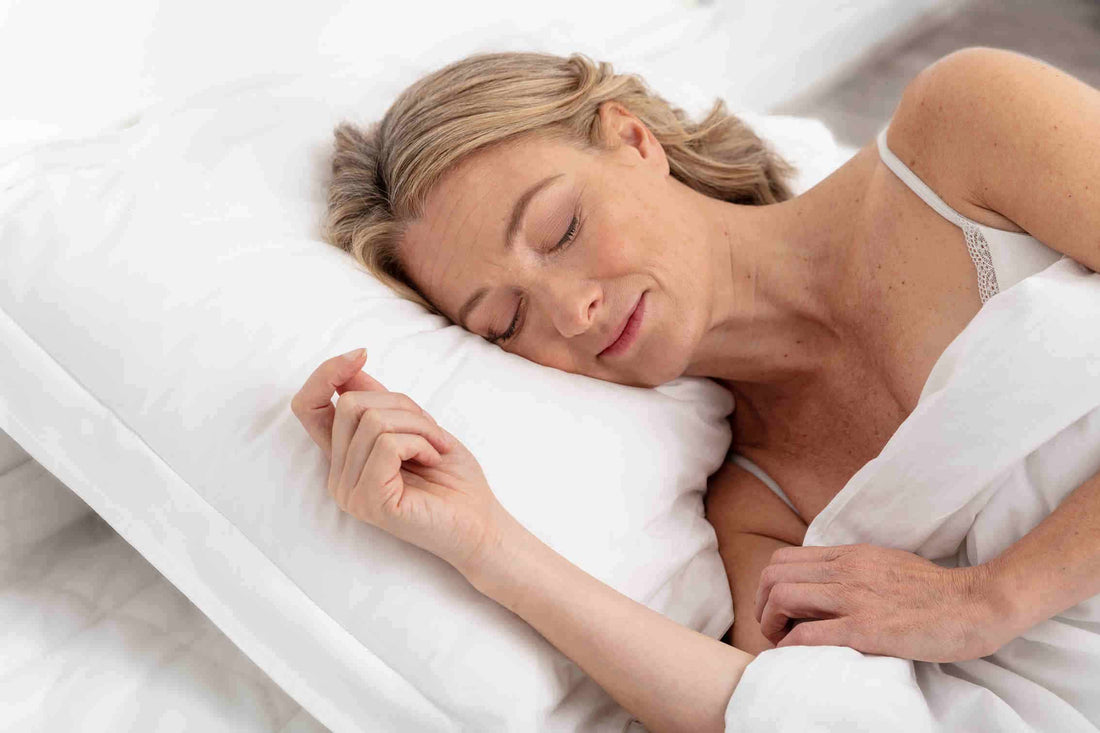If you’re struggling to fall asleep, or stay asleep through the night, you’re not alone. In this article, Dr. Sophie Bostock, sleep expert and evangelist, explains why menopause can make you tired, what kind of sleep problems can occur during menopause and why fatigue and tiredness can feel so overwhelming at menopause, and signposts evidence-based strategies for improving your sleep.
How common are sleep problems during menopause?
Sleep problems are very common in the general population, with as many as 1 in 3 adults reporting trouble sleeping. There is no doubt that menopause creates additional challenges for sleep, with most surveys suggesting that at least 1 in 2 women during have difficulty falling asleep, or waking up during the night, during the menopausal transition.(1,2)
Recent data from the Health & Her Menopause Symptom Tool and Tracker reveals that over three quarters of women using the tool have trouble sleeping.

The good news? Although widespread, this tells us that sleep problems are not universal, or inevitable.
For many women, sleepless nights are temporary, but research suggests that as many as 1 in 4 women going through menopause may meet criteria for insomnia disorder. (1) Doctors define insomnia disorder as difficulties falling asleep, staying asleep through the night, or waking up feeling unrefreshed which persists for at least 3 nights a week, for 3 months or more, and which have a serious negative impact on work, relationships, health or quality of life.(3)
Is menopause to blame for my poor sleep?
If you’re regularly woken up by night sweats, you probably feel in little doubt that menopause is to blame for poor sleep. But whether or not you experience hot flushes, sleep is vulnerable to a range of different influences which coincide with the onset of menopause:
Hot flushes and night sweats: Night sweats typically start to disrupt sleep in perimenopause and persist for several years postmenopause. Not all hot flushes wake you up, but they are associated with increased arousal in the brain, which is linked to lighter sleep.(4) To maintain deep sleep, the body needs to cool down, so when your internal temperature dial is running wild, it interferes with both getting to sleep, and staying asleep.
Mental health challenges: Menopause also often coincides with stressful life events. Lower levels of oestrogen can alter the regulation of hormones and transmitters which influence mood, such as serotonin, making you more vulnerable to depression.(1) Sleep and mental health are closely connected: poor mental health tends to get in the way of quality sleep, and lack of sleep heightens our sensitivity to stress, making us more vulnerable to anxiety and depression.(5) If you feel like you’re stuck in a cycle of stress and sleeplessness, focusing on taking control of your sleep can often by the simplest way to start to tackle that cycle.
Pain: Oestrogen levels influence both pain perception and inflammation, and recent studies have found an increase in chronic pain during menopause, which can disrupt sleep.(6) The timing of menopause also coincides with an increase in the diagnoses of chronic health conditions, which may also add to pain and discomfort.
Waking to urinate at night (nocturia): Lower levels of oestrogen can lead to drying of the genital tract, discomfort and strong urges to urinate; another cue for disrupted sleep.(1)
Natural ageing: Older adults typically experience lighter and more disrupted sleep than younger adults, especially in the second part of the night. We sleep in cycles which are typically about 90-110 minutes long. It’s important to know that waking up several times between sleep cycles is natural; most good sleepers roll over and forget about it. Try not to let waking up itself become a source of anxiety. If you don’t worry about waking up, it’ll be much easier to fall back to sleep.
Other sleep disorders: Insomnia is the most common sleep disorder, but there are other common conditions which merit medical attention. Obstructive Sleep Apnea (OSA) is a condition where narrowing of the upper airways leads to pauses in breathing throughout night, and is often associated with loud snoring. OSA disrupts deep sleep and leads to extreme sleepiness during the day. Sleep apnea can occur at any age but becomes more common in postmenopausal women, potentially because of a reduction of the hormone progesterone. Restless Legs Syndrome (RLS) is the sudden urge to move your legs can interfere with getting to sleep. RLS seems to be more common in perimenopause, especially for women who have night sweats.(7)
What impact can poor sleep have on menopause?
Lack of sleep can have a pretty miserable impact at any time of life, but the effects on menopause are particularly significant because sleeplessness tends to magnify the negative effects of hormonal changes, which can worsen a whole range of symptoms, which further disrupt sleep.. leading to a negative spiral.
For example, lack of sleep alone can cause fatigue, greater sensitivity to pain, memory loss, a reduction in sexual arousal, weight gain and increased inflammation – all of which can also be consequences of menopause.2 The effects of sleep are particularly notable for mental health. For example, one night without sleep can increase anxiety by 30%, fuelling worry and stress levels.(8)
Data from Health & Her’s Symptom Tool reinforces the links between poor sleep and worse physical and mental health. In a sample of over 30,000 women, those with severe sleep problems experience an average of 10 menopause symptoms, vs. 6 for good sleepers. The severity of symptoms for the poorest sleepers was also higher – 3.6 out of 5 on average, vs. 3.1 out of 5 for good sleepers.
It’s important to note that you don’t need to ‘catch up’ on every hour of missed sleep. Rather than lying in bed, worrying about lack of sleep, a better approach is to get out of bed and do a relaxing activity, only returning to bed if you’re sleepy tired. After a sleepless night, the brain will try and compensate with a more restorative sleep the following night.
What can you do to improve sleep quality?
If you understand how sleep works, you can feel more confident about practicing positive sleep habits, which could prevent occasional sleep problems turning into full blown insomnia. So what controls when we sleep? There are two main forces involved(9):
a) Your circadian rhythm, or body clock Our bodies are designed to operate on a 24 hour or ‘circadian’ sleep-wake cycle, to allow for action during the day, and recovery at night. Every cell has its own internal clock, but a master body clock in the brain keeps them all coordinated. The master clock is very sensitive to light; in daylight, it sends a strong alerting signal, whereas in darkness, it sends a ‘ready-to-sleep’ signal, via production of the hormone, melatonin. We produce less melatonin as we age (regardless of menopause) which is one reason sleep gets lighter as we get older.
b) Sleep pressure
Sleep pressure builds up gradually the longer we’ve been awake, owing to build up of a waste chemical called adenosine, making us feel drowsy. Sleep pressure works independently to the body clock and is reset by sleep. If sleep pressure is high, and there is no alerting signal from the master clock, we’re likely to sleep. Most sleep hygiene advice, including the advice below, is designed to help these two natural sleep forces work together.
1. Maintain a regular wake-up time: if you get up at similar times every day, your body responds with the regular release of melatonin before you get into bed, which aids restful sleep. Haphazard sleep-wake patterns, and weekend lie-ins, confuse the body clock and delay the production of melatonin, leading to lighter sleep.
2. Use bright light to energise: Sit by the window or go outdoors in the morning to feel more alert, and wake up the body clock. In the hour before bed, dim the lights, and avoid light from screens which can interfere with melatonin. During the night, keep your environment as dark as possible, with blackout blinds and/or an eye mask, and use dim lights if you need to get up at night.
3. Practice the skill of relaxation: too much stress, especially in the evening, interferes with the production of melatonin. This can delay the body clock and lead to lighter, more disrupted sleep. Take time to unwind and detach from the day before bed. Relaxation techniques such as progressive muscle relaxation, yoga and mindfulness can all help switch off the stress response, and lead to more restorative sleep.
4. Go to bed when you’re sleepy: you won’t be able to sleep if you haven’t built up enough sleep pressure. If you don’t feel tired, do something relaxing until your eyelids feel heavy, and only then get into bed. If you’re feeling fatigued, a short 20 minute nap after lunch can be a useful boost to mood and energy levels, but be wary of long naps late in the day which can reset sleep pressure, and interfere with night time sleep.
5. Cut down on stimulants: caffeine temporarily masks the effects of sleep pressure, and increases arousal. Even caffeine 6 hours before bed can interfere with sleeping through the night.10 Some people use alcohol to get to sleep but as it is broken down by the body it interferes with natural sleep, leaving you feeling fatigued the next day. Caffeine and alcohol can both worsen night sweats and hot flushes.
6. Get active during the day: physical activity sends a signal to the master body clock to stay alert, and helps strengthen sleep pressure. Regular physical activity improves sleep quality at all ages. Avoid vigorous exercise close to bedtime, since this can increase body temperature, and push back the body clock.
7. Keep the bedroom cool at night: a daily fall in body temperature is a cue for sleep, so keeping your bedroom a few degrees cooler than typical room temperature, with air circulating, can help. Use layers of light bedding which you can easily remove if you get too hot. Some women who experience severe night sweats recommend sleeping on soft towels, which are easy to change at night.
What treatments are available for persistent sleep problems in menopause?
If you’re concerned about a chronic sleep problem, it’s a good idea to discuss this with your doctor. A multidisciplinary approach to treatment is recommended, which takes into account not only your hormonal profile, but also any pain or chronic health conditions, and what’s going on in your work and family life, and your treatment preferences.(1)
The recommended first line treatment for Insomnia Disorder is called Cognitive Behavioural Therapy for Insomnia (CBT-I).(2,11) Like other CBT approaches, CBT-I is a toolkit of different techniques to address unhelpful thoughts and worry, but also helps to reset healthy sleep patterns. Techniques include using a sleep diary, good sleep hygiene, relaxation techniques, and sleep restriction, which involves changing your sleep window to increase sleep pressure, and consolidate broken sleep. CBT-I can be delivered effectively as 1-2-1 or group therapy, as self-help books or online programmes.
Hormone Replacement Therapy (HRT) is commonly prescribed to manage hot flushes, and most studies report a modest improvement in sleep quality, as well as low mood.(1,2)
A recent trial compared 6 different approaches to improving insomnia in over 500 women with hot flushes over 12 weeks.(12) The strongest improvements in sleep quality were reported for CBT-I. Interestingly, while CBT-I didn’t reduce the number of night sweats, it did reduce how bothersome they were, and improved overall satisfaction with sleep. Smaller sleep improvements were seen for HRT (oestradiol), antidepressants (escitalopram, venlafaxine), regular aerobic exercise and yoga. Omega-3 supplements had no effect.
Sleeping pills are not recommended for more than a few weeks use owing to potentially harmful side effects, so are rarely prescribed at menopause. Taking pills won’t help to address the behaviours that get in the way of sleep, so even if you’re using pills as a temporary measure, it’s also a good idea to focus on positive sleep habits.
What alternative approaches are there?
If you find an approach which helps you to cope with hot flushes and night sweats, it’s likely to have benefits for sleep too. Similarly, rituals which help you to relax and detach from the day in the hour or two before bed can help ready the mind and body for sleep. For some people this might mean a warm bath, herbal tea, reading, writing a journal or meditation(13); whatever helps you personally to put the day to rest.
Dietary factors can also influence sleep. Maintaining a varied and healthy diet will help to prevent deficiencies of nutrients which have been linked with poor sleep, such as magnesium, calcium, vitamin D and 5-HTP (a precursor to melatonin).(14) Research into the effects of dietary supplements on sleep at menopause has mostly been limited to small trials, but it’s an active area for research. For example, isoflavones, which can mimic the effects of oestrogens, and valerian root, have been shown to have mild sedative effects.(15) A registered nutritionist can help you to apply the latest evidence for supplements, as well as understanding risks and side effects.
Key takeaways
There are many simple things you can do to improve your natural sleep quality. The approach with the strongest evidence for reducing insomnia in menopause is CBT-I. Simply knowing that poor sleep can turn up the dial on your emotional sensitivity can be empowering. If you feel tired and overwhelmed, remind yourself that the sleepless brain has a tendency to hijack logical thoughts and feelings. Try and look at the situation from your best friend’s perspective. Protect time to unwind before bed to give your body the best chance for a restful slumber.
References
- Hachul et al. (2017) Chapter 10. Insomnia and Menopause Clinical Handbook of Insomnia (Current Clinical Neurology) (3rd edition) Ed. Attarian
- Baker et al. (2018) Sleep problems during the menopausal transition: prevalence, impact, and management challenges Nature and Science of Sleep 2018:10 73–95
- American Psychiatric Association: Diagnostic and Statistical Manual of Mental Disorders: Diagnostic and Statistical Manual of Mental Disorders, Fifth Edition. Arlington, VA: American Psychiatric Association, 2013
- Bonnani et al (2019) Insomnia and hot flashes. Maturitas 126 (2019) 51–54
- Fang et al (2019) Depression and sleep disturbance: a review on a bidirectional relationship, mechanisms and treatment J Cell Mol Med. 23(4): 2324–2332.
- Gibson et al. (2019) Menopause symptoms and chronic pain in a national sample of midlife women veterans Menopause 26(7):708-713
- Joffe et al. (2010) Evaluation and Management of Sleep Disturbance During the Menopause Transition Seminars in Reproductive Medicine 28(5):404-21
- Ben Simon et al (2020), Overanxious and underslept. Nature Human Behaviour, 4, 100–110(2020)
- Borbely et al (2016) The two‐process model of sleep regulation: a reappraisal. J Sleep Res 25(2) 131-143
- Drake et al. (2013) Caffeine effects on sleep taken 0, 3, or 6 hours before going to bed. J Clin Sleep Med 9(11):1195-120
- Nowakowski & Meers (2019) Cognitive Behavioral Therapy for Insomnia and Women’s Health: Sex as a Biological Variable Sleep Med Clin 14(2):185-197
- Guthrie et al (2019) Effects of Pharmacologic and Nonpharmacologic Interventions on Insomnia Symptoms and Self-reported Sleep Quality in Women With Hot Flashes: A Pooled Analysis of Individual Participant Data From Four MsFLASH Trials. Sleep 41(1)
- Garcia et al. (2018) The effects of mindfulness and relaxation training for insomnia (MRTI) on postmenopausal women: a pilot study. Menopause25(9):992-1003
- Ikonte et al. (2019) Micronutrient Inadequacy in Short Sleep: Analysis of the NHANES 2005-2016. Nutrients 11(10)
- De Franciscis et al. (2019) A Nutraceutical Approach to Menopausal Complaints. Medicina 55(9)E544



